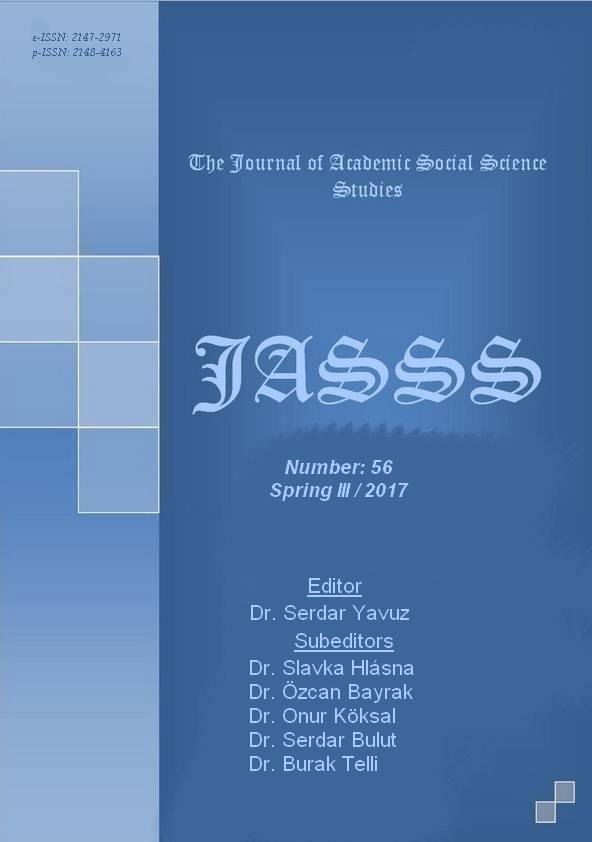Author :
Abstract
Bu araştırmanın amacı, DNR tabanlı öğretimin 8. sınıf öğrencilerinin olasılık ve istatistikle ilgili anlama ve düşünme yollarına etkisini incelemektir. Bu amaç doğrultusunda araştırma ön test-son test kontrol gruplu yarı deneysel desene uygun olarak tasarlanmıştır. Araştırmanın çalışma grubunu İstanbul İli Bayrampaşa İlçesi’ndeki bir devlet ortaokulunda öğrenim görmekte olan 80 sekizinci sınıf öğrencisi oluşturmuştur. Araştırmada bir deney (n = 40) ve bir kontrol grubu (n = 40) yer almıştır. Deney grubunda öğretim DNR tabanlı öğretim ile gerçekleştirilirken, kontrol grubunda var olan normal öğrenme süreci devam etmiştir. Toplam 6,5 hafta (26 ders saati) süren araştırmada veriler, “8. Sınıf Matematik Başarı Testi (8MBT)”,“Anlama ve Düşünme Yollarını Belirleme Testi (ADYBT)” ve etkinlik çalışma yaprakları ile toplanmıştır. Araştırmada elde edilen nicel veriler, istatistiksel bir program aracılığıyla analiz edilirken; nitel veriler ise öğrencilerin olasılık ve istatistikle ilgili anlama ve düşünme yollarını değerlendirmek amacıyla geliştirilen “Anlama ve Düşünme Yollarını Değerlendirme Formu’na (ADYDF)” göre betimsel olarak analiz edilmiştir. Veri analizinde, öğrencilerin problem çözme sürecinde kullandıkları doğrulama şemaları Harel ve Sowder (1998) tarafından geliştirilen ispat şemaları modeline göre dışsal, deneysel ve analitik olarak kodlanmıştır. Araştırmada elde edilen bulgular doğrultusunda, DNR tabanlı öğretimin öğrencilerin olasılık ve istatistik ile ilgili anlama ve düşünme yollarının gelişiminde, normal öğretim sürecine göre daha etkili olduğu sonucuna ulaşılmıştır. Buna göre, uygulama sonrasında deney grubu öğrencilerinin genel olarak olasılık ve istatistik ile ilgili kavramlara yönelik çok yönlü anlama yolları sergiledikleri, problemler için farklı çözüm stratejileri geliştirdikleri ve cevaplarını doğrulama sürecinde analitik şemayı kontrol grubu öğrencilerine göre daha fazla kullandıkları tespit edilmiştir.
Keywords
Abstract
The aim of this research is to examine the effects of DNR-based instruction on 8th Grade Students' ways of understanding and thinking about probability and statistics. For this purpose, the research is designed according to the quasi-experimental design with pre-test-post-test control group. The study group includes 80 eighth grade students studying in a public middle school in Bayrampasa District of Istanbul. There is an experiment (n = 40) and a control group (n = 40) in the study. The normal learning process in the control group continued while DNR-based teaching was carried out in the experimental group. The data in the study which lasted for totally 6.5 weeks (26 hours), were collected through "8th Grade Mathematics Achievement Test’ (8MAT)", ‘The Test of Determining Ways of Understanding and Thinking’ (TDWUT) and activity worksheets. While the quantitative data obtained in the research were analyzed through a statistical program; qualitative data were analyzed descriptively according to ‘Evaluation Form of Ways of Understanding and Thinking’ (EFWUT) which was developed to evaluate students' ways of understanding and thinking about probability and statistics. In the data analysis, the justification schemes used by the students in the problem solving process were coded as external, empirical and analytical according to proof schemes model which was developed by Harel and Sowder (1998). In line with the findings obtained in the research, it is concluded that the students with DNR-based instruction are more effective in developing the ways of understanding and thinking about probability and statistics than the normal teaching process. According to this, it has been determined that students in the experimental group generally had multiple ways of understanding the concepts related to probability and statistics, developed different solution strategies for the problems and used the analytical scheme more than the control group in the process of verifying their answers.





